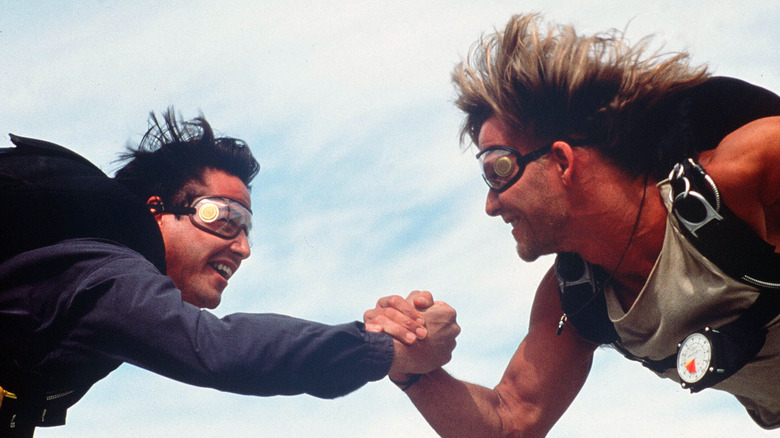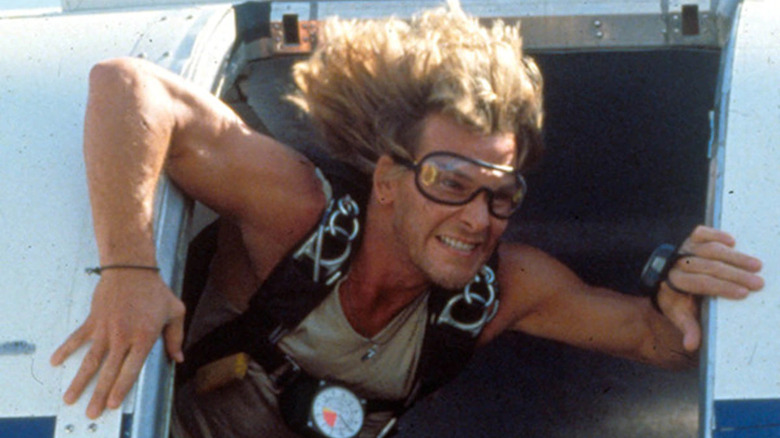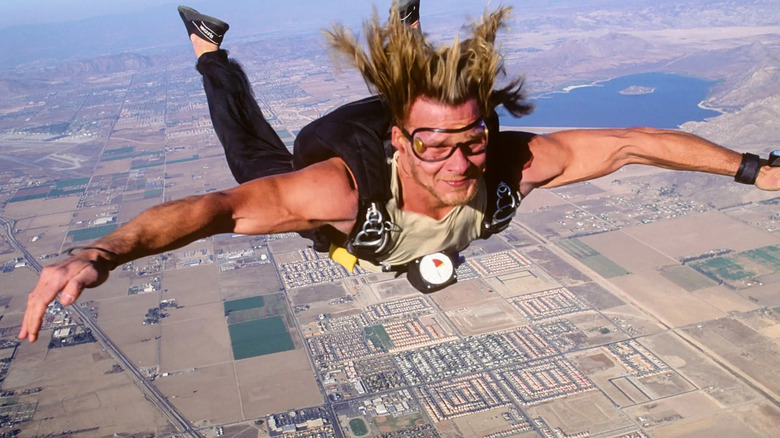Some Clever Editing Helped Pull Off Point Break's No Parachute Scene
In 1991, filmmaker Kathryn Bigelow dared to ask one of cinema's most crucial questions: What's better than guys being dudes? The sprawling, manifold answer was thoroughly mapped out in "Point Break," a tale of surfing, crime capers, and concealed identities. Perhaps most of all, Bigelow's film unravels the surprising ways that an otherwise genuine human connection can disarm and delude us, presented in the central bond between undercover FBI agent Johnny Utah (Keanu Reeves in the role that would forever brand him as a "himbo") and at-large bank robber Bodhi (Patrick Swayze). Granted with a sizable hunch on behalf of the bureau, Utah is tasked with infiltrating a local surfing scene in order to discern if any of these thrill-seeking wave riders might have an attachment to the "ex-presidents," a bank robbing troupe that dons rubber masks of their namesakes. While putting the pieces together — and finding Bodhi and his three adrenaline-junkie buddies to be the perfect culprits — Utah becomes intoxicated by the group's free-wheeling ethos, enticed by their thirst for freedom and the welcome contrast it provides from his bureaucratic day job.
Of course, as Utah becomes further entwined with the group, his identity as an undercover agent threatens to be revealed. As Bodhi realizes that Utah's not who he claims to be, a pivotal climactic scene ensues: with all of them being experienced skydivers (even having previously taken Utah out on a jump), they plot their last heist and plan to escape via airplane drop to Mexico. After their robbery goes horribly wrong — resulting in the death of one of the ex-presidents and Utah's partner Angelo Pappas (Gary Busey) — Utah chases Bodhi and one of his critically wounded accomplices onto a plane set for Mexico. When they fly over their intended drop zone, Bodhi and his fellow bank robber disembark mid-air, taking the only two parachutes on board with them. Johnny Utah must make a split-second decision: go down with the plane, or free-fall and catch Bodhi at 4,000 feet.
Of course, as one of the greatest action films ever made, "Point Break" takes that leap with filmmaking finesse. Let's take behind-the-scenes look at this amazing cinematic moment — figuring out just how the hell Bigelow pulled this off, while revealing the wild feats of fearlessness cast members and stunt doubles alike (literally) embraced in order to capture the real sensation of falling without a safety net.
Real-life free-falls
What makes this scene in "Point Break" so amazing is that on-set risk-taker Patrick Swayze did, indeed, jump out of a high-flying airplane during this scene. But let's be clear: Swayze was no amateur by the time they filmed this pivotal scene in the film. According to Karen Thomas of USA Today, the acting adonis ended up making over 50 jumps for the film, effectively becoming enamored with the sensation of skydiving during filming. This is only a tenth of the jumps that Swayze's brother, Don, has to his name, having jumped a whopping 500 times. Apparently, this need for speed runs in the family.
Yet, the real-life jump also added an enormous boon to the film's thrilling action, causing gasps among audience members who recognize that Swayze's jump was, in fact, real. The camera holds on Swayze, who gracefully falls backwards out of the doomed aircraft. There's no special effect magic here — the actor really did skydive to capture that all-important shot. When the camera pans back to Reeves, however, it's (somewhat) clear that we are no longer on an actual moving airplane. This appears to be a static set made to simulate the sensation of being up in the air. Reeves' amazing action-shot required a bit more than guts to accomplish: His gutsy free-fall descent required the magic of the movies, accomplished with the help of stellar practical effects.
A skydiving simulation rig
For the benefit of insurance costs and to ensure the safety of the actors involved, a skydiving simulation rig was constructed on the "Point Break" set. This proved particularly useful during the close-up shots of Swayze and Reeves, the latter appearing to free-fall and managing to latch onto the former's parachute-strapped torso. Again, Utah must make another vital decision: drop his gun and pull the string that will release the parachute, saving them both, or shoot Bodhi in the head and open the parachute on a dead man's body. Due to the connection they've forged during the first half of the film — and having been previously unable to shoot Bodhi — Utah drops the gun and pulls the string with seconds to spare.
Of course, one of the major reasons for constructing this 10-foot rig also has to do with the fact that it's virtually impossible to hold a conversation while falling at those speeds. The noise of whipping winds is simply too strong to allow for communication, even if the two parties are right in each other's faces. By using industrial-strength fans, Bigelow was able to direct the duo while still capturing their conversation clearly. Still, Swayze — thanks to his skydiving experience — knew that this exchange was nearly impossible (per Film School Rejects):
"You can't talk in free fall. You've got 120 to 200 mile an hour winds which is nothing but a giant roar. So there is a little bit of poetic license taken with us having conversations."
However, suspending our disbelief as viewers during this dialogue is infinitely easier when such daring stunts are being performed by the actors in front of our very eyes. Let's not get too far ahead of ourselves, though — the truly shocking moment of Johnny Utah swan diving sans-parachute was executed by a talented stunt performer, and not all of Bodhi's skydiving shots were executed by Swayze.
Double stunt doubles
When the audience witnesses Utah jump out of the plane and dive head-first toward Bodhi, it's likely that the initial descent only goes as far as Reeves falling a few feet onto a crash mat. However, Reeves' stunt double really does take the plunge, seemingly hurtling through the air without any safety support. Upon closer inspection, though, the stunt double simply has the parachute hidden under his shirt, ready to burst open when the moment comes off-screen. Similarly, the shots of Utah and Bodhi falling together with only the latter's parachute was also performed by two stuntmen, who in reality had their own separate vests that are merely connected to simulate the illusion of there only being one. Apparently, it's virtually impossible for two people to use one parachute in order to safely crash-land, making the mechanics of this illusion another venture in making the impossible appear tangible.
It appears that an assortment of cinematic techniques were employed in the filming of "Point Break," from the clever editing that showed Swayze's real-life jump juxtaposed with Reeves' static on-set reaction to the use of skydiving simulation rigs and, of course, the tireless efforts of stunt performers who take huge risks in allowing the outlandish appear ordinary on film. As an eternal fan of the himbo film canon, "Point Break" endures as the platonic ideal. Men jumping out of planes and exchanging a sexually-charged embrace? Now that's what I call cinema, baby.


